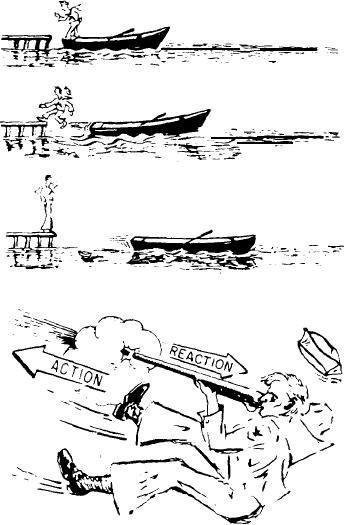
motion (1) if all air resistance were removed,
the surface were perfectly level.
NEWTON'S SECOND LAW.--Newton's
second law states that an imbalance of force on
a body tends to produce an acceleration in the
direction of the force. The acceleration, if any,
is directly proportional to the force. It is inversely
proportional to the mass of the body. This law
can be explained by throwing a common softball.
The force required to accelerate the ball to a rate
2
of 50 ft/sec would have to be doubled to obtain
2
an acceleration rate of 100 ft/sec . However, if
the mass of the ball were doubled, the original
acceleration rate would be cut in half. You would
2
2
have 50 ft/sec reduced to 25 ft/sec .
NEWTON'S THIRD LAW.---Newton's third
law states that for every action there is an equal
and opposite reaction. You have demonstrated
this law if you have ever jumped from a boat up
to a dock or a beach. The boat moved opposite
to the direction you jumped. The recoil from
firing a shotgun is another example of action-
reaction. Figure 4-10 depicts these examples.
In an airplane, the greater the mass of air
handled by the engine, the more it is accelerated
by the engine. The force built up to thrust the
plane forward is also greater. In a gas turbine,
the thrust velocity can be absorbed by the turbine
rotor and converted to mechanical energy. This
is done by adding more and progressively larger
Figure 4-10.--Newton's third law of motion.
power turbine wheels.
factors concerning noncompressible fluids.
Pascal's Law
Consider the system shown in figure 4-11.
Chamber A is under pressure and is connected
Blaise Pascal was a French philosopher and
by a tube to chamber B, which is also under
mathematician who lived from 1623 to 1662 A.D.
pressure. Chamber A is under static pressure
His work, simply stated, could be interpreted as
of 100 psi. The pressure at some point, X,
pressure exerted at any point upon an enclosed
along the connecting tube consists of a velocity
liquid is transmitted undiminished in all
pressure of 10 psi. This is exerted in a direction
directions.
parallel to the line of flow. Added is the
Pascal's law governs the BEHAVIOR of the
unused static pressure of 90 psi, which obeys
static factors concerning noncompressible fluids
Pascal's law and operates equally in all directions.
when taken by themselves.
As the fluid enters chamber B from the
constricted space, it is slowed down. In so
Bernoulli's Principle
doing, its velocity head is changed back to
pressure head. The force required to absorb
Jacques (or Jakob) Bernoulli was a Swiss
the fluid's inertia equals the force required to
philosopher and mathematician who lived
start the fluid moving originally. Therefore, the
from 1654 to 1705 A.D. He worked extensively
static pressure in chamber B is again equal to
with hydraulics and the pressure-temperature
that in chamber A. It was lower at intermediate
relationship. Bernoulli's principle governs the
point X.
RELATIONSHIP of the static and dynamic
4-10

